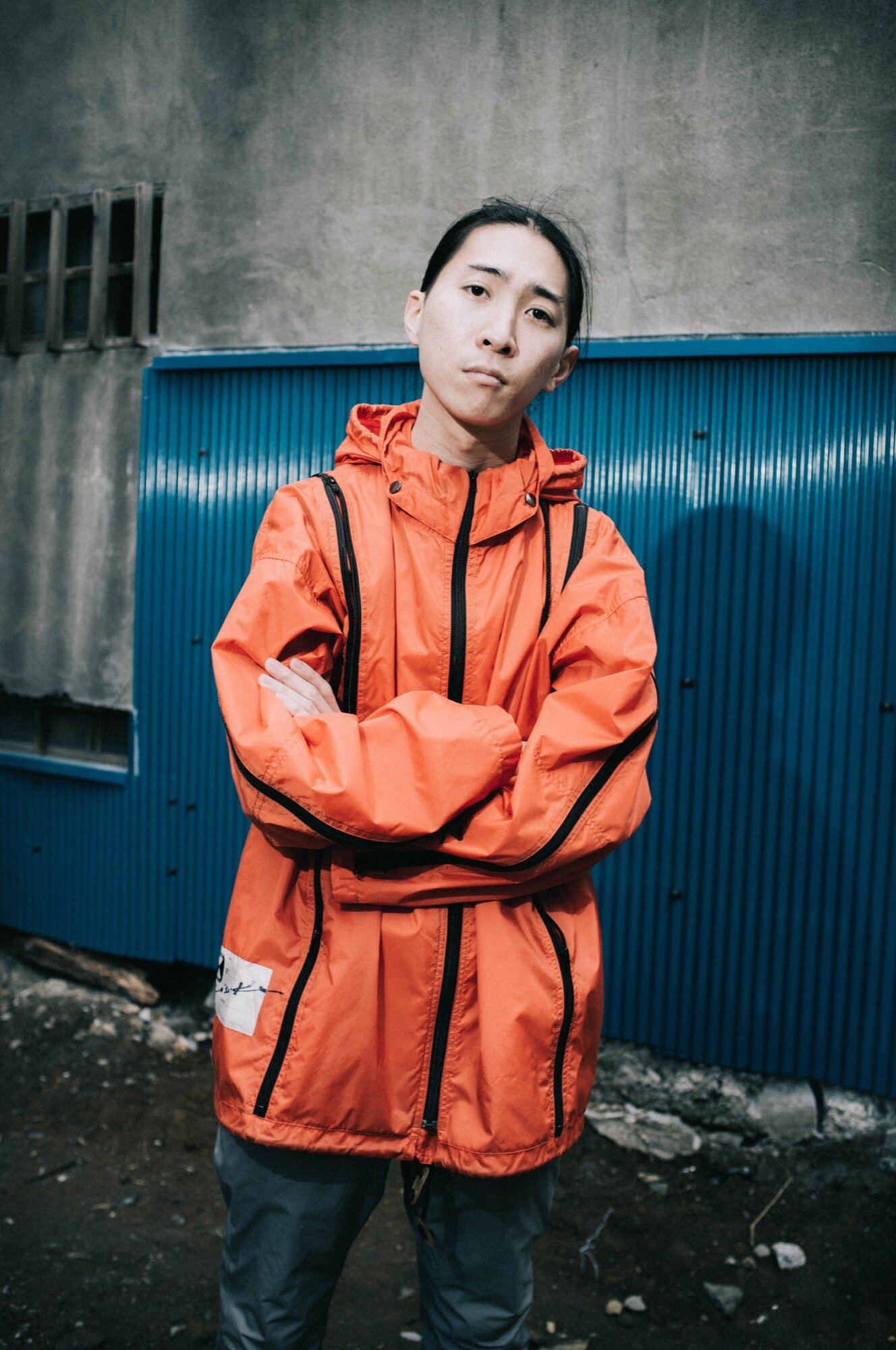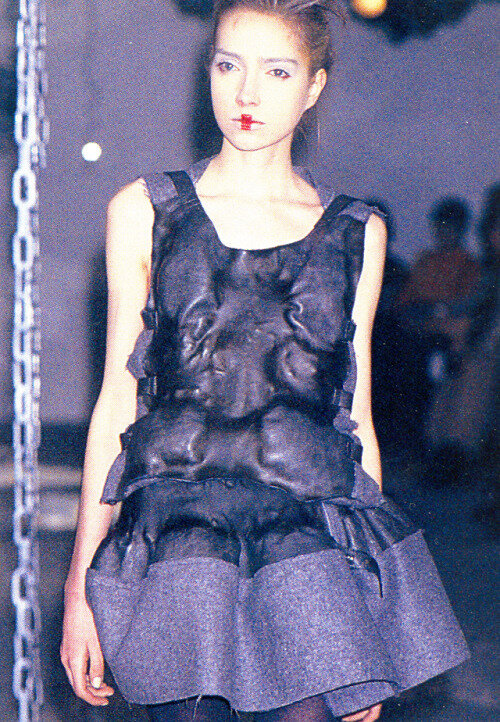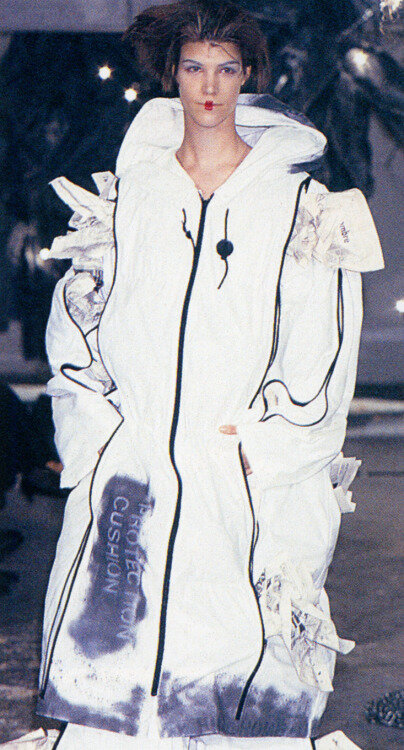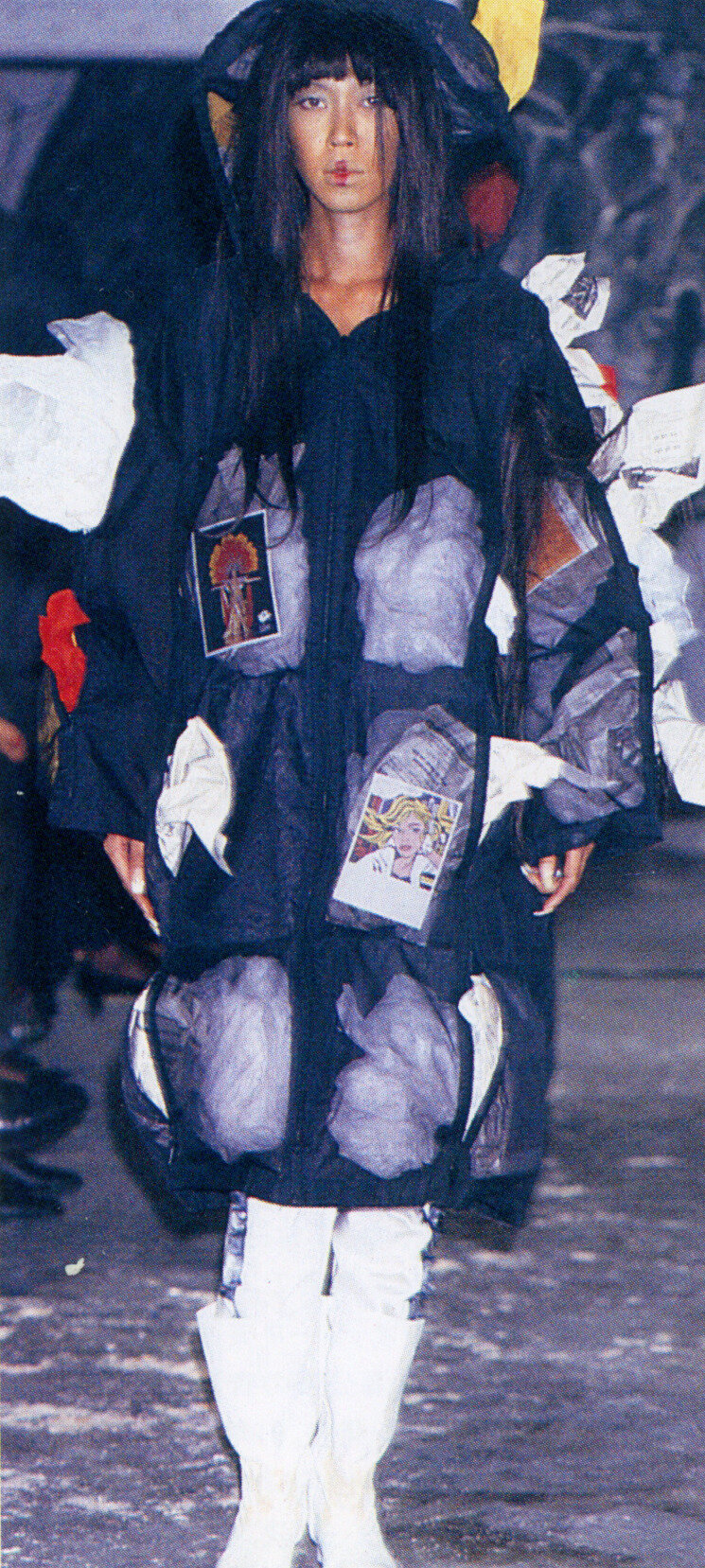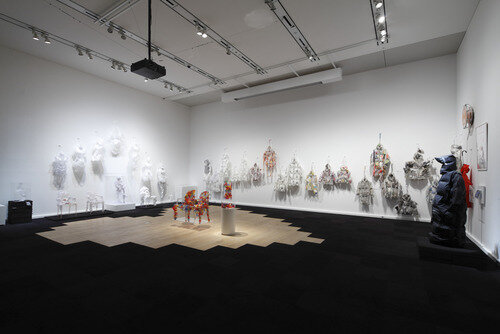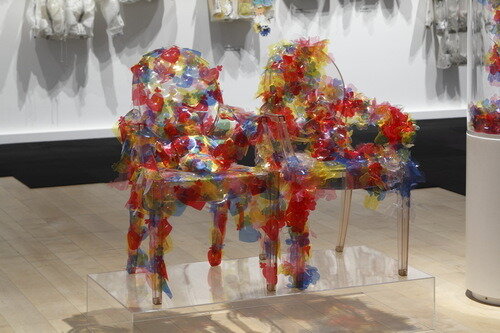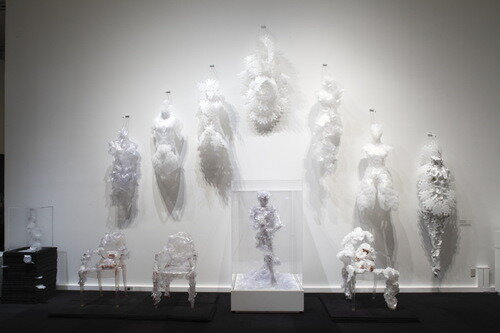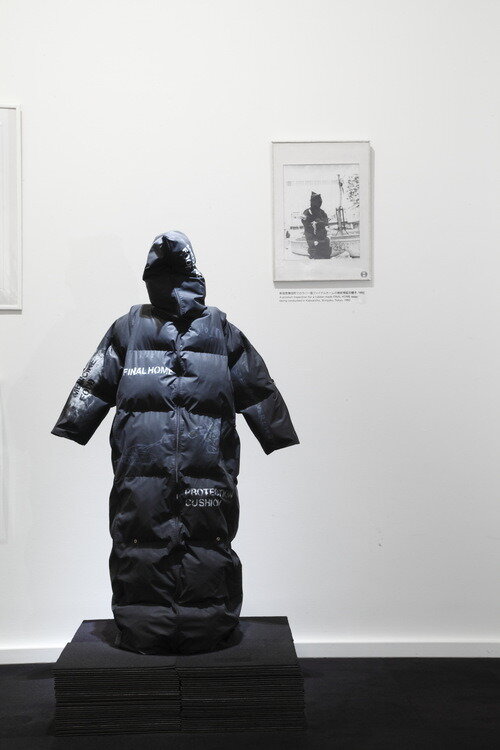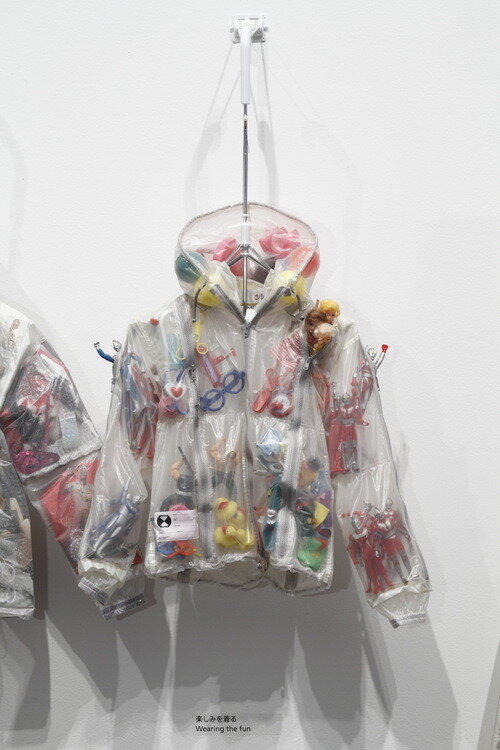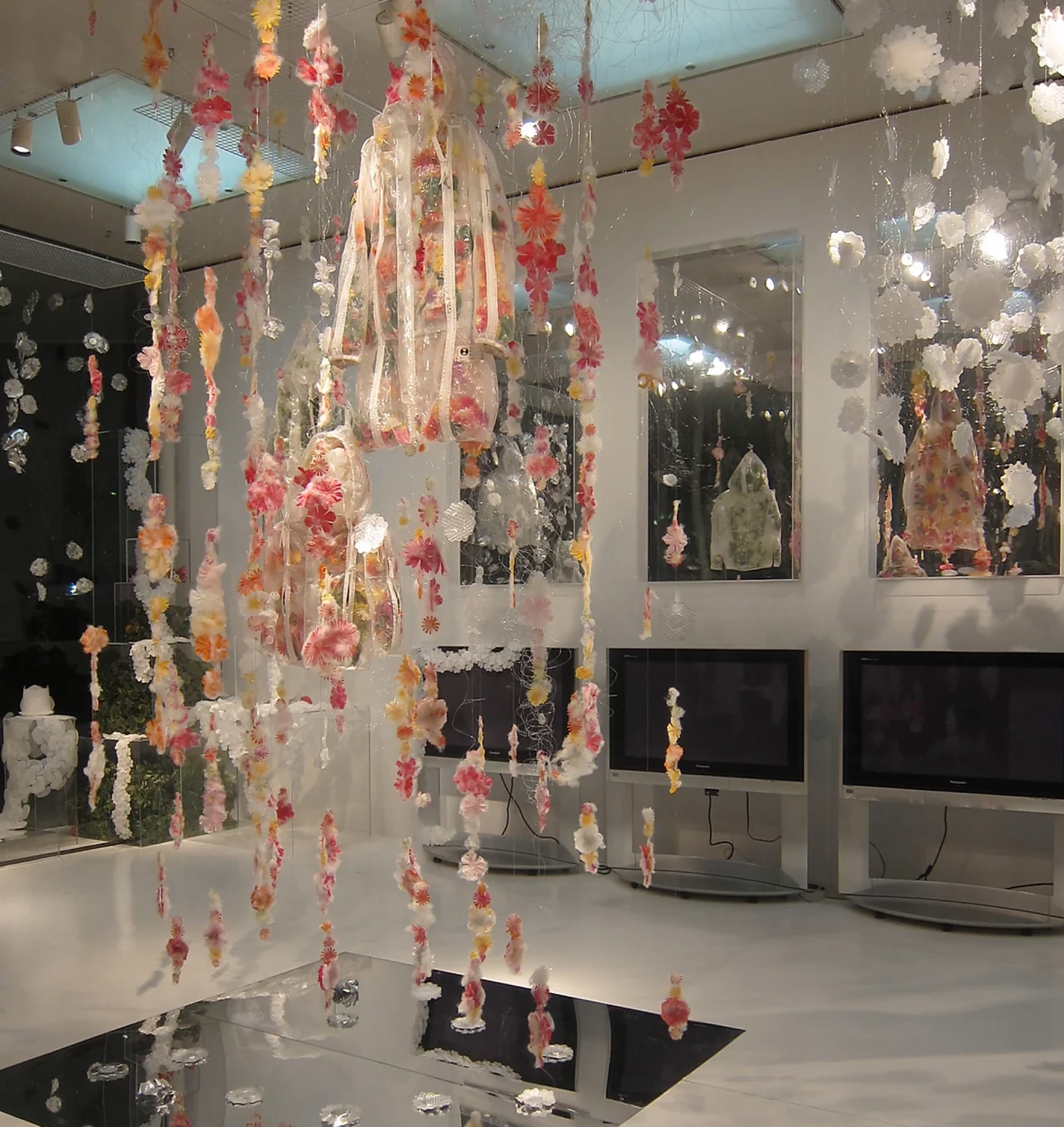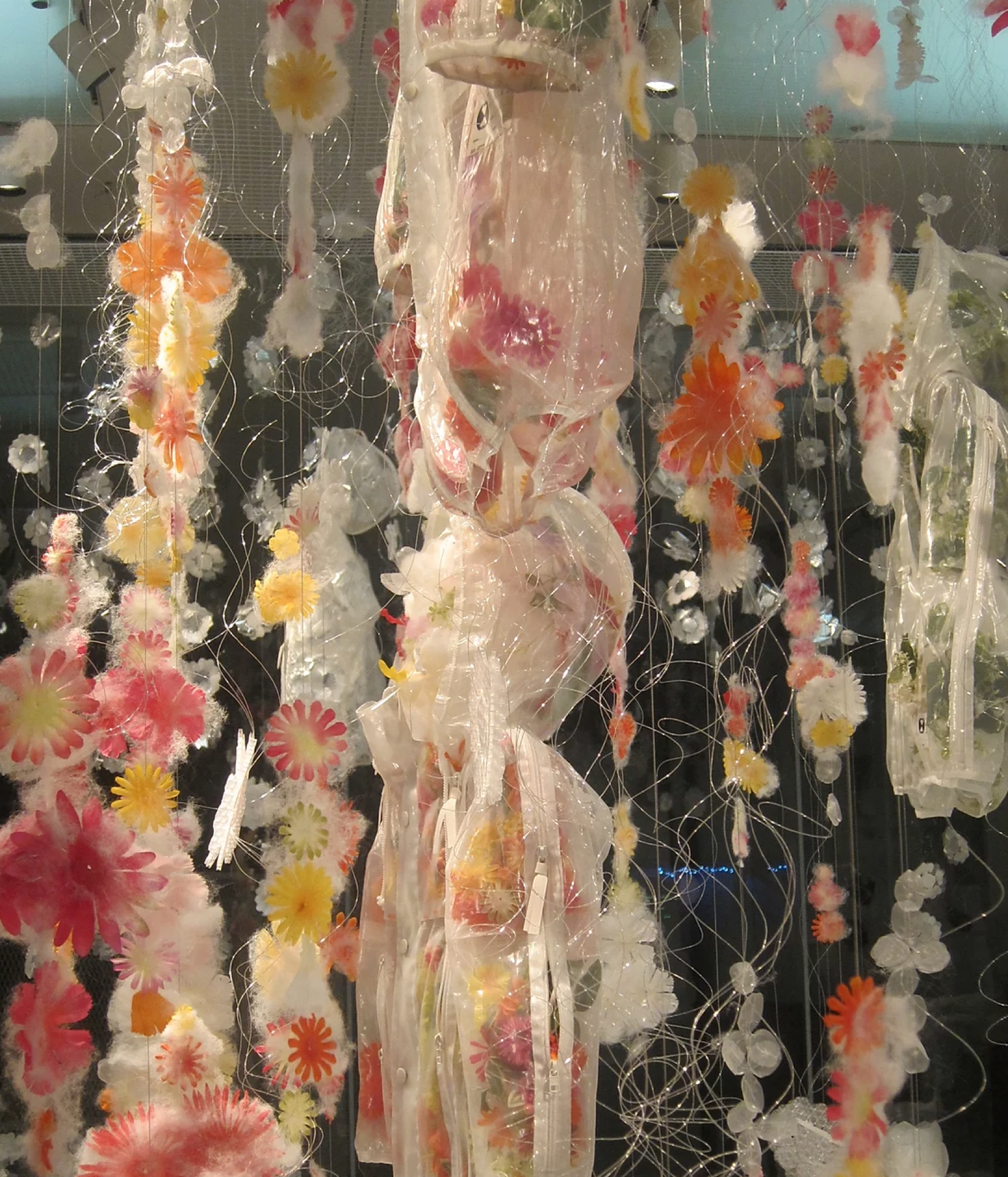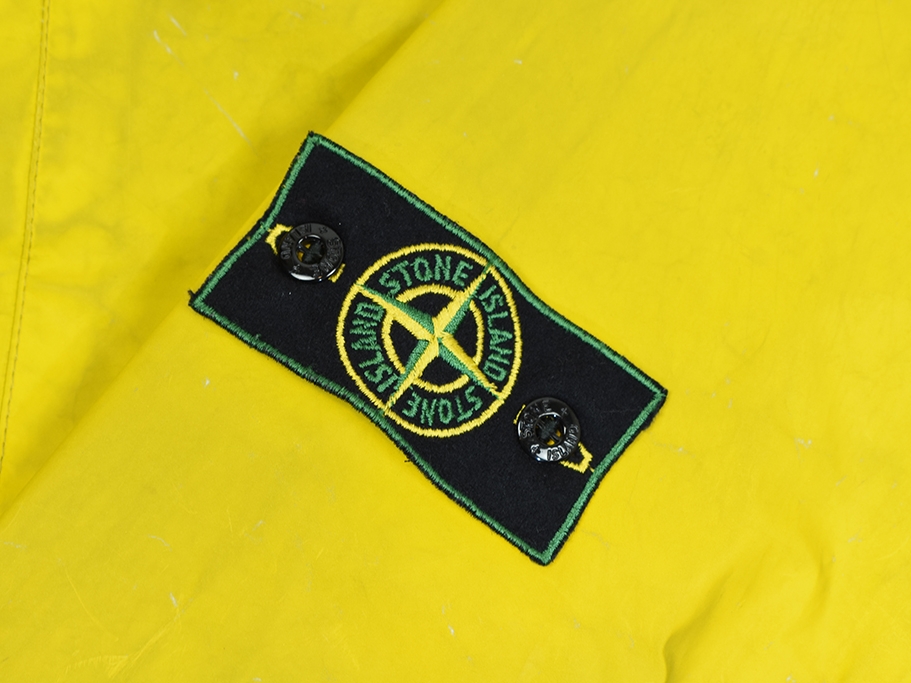THE STORY OF FINAL HOME AND KOSUKE TSUMURA
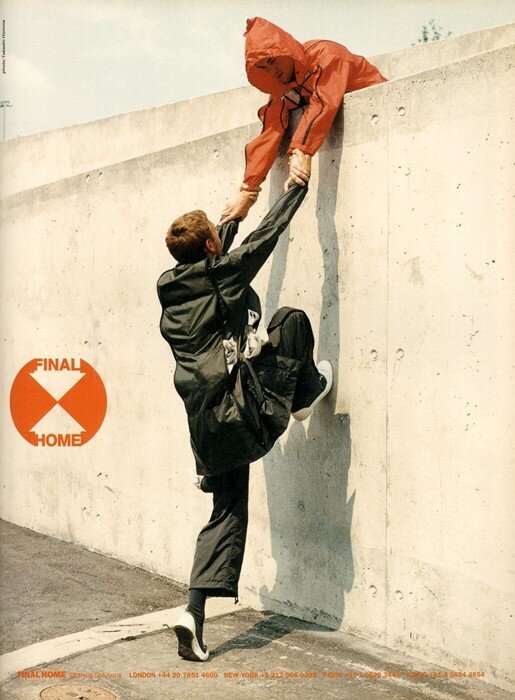
Japan is the birthplace of many legendary designers and brands. From Rei Kawakubo to Yohji Yamamoto, through to Junya Watanabe who’s labels are worn and sold worldwide up until today.
Besides the big names that are widely known through popular and sub-cultures, the names which made their way from the avant-garde beginnings and worked their way up and through the mainstream in the form of small hearts on shoes and big lettering on jackets - there is more to discover.
Some of the most influential designers and brands are still well-kept or almost-kept secrets.
Your favourite designer's inspiration or idol will not always land in your local high-end boutique or be channelled through the sneaker collaborations on your feet - but their impact will be there forever.
One of these names is Kosuke Tsumura and his utopian brand FINAL HOME.
picture by Adrian Bianco
A brand that paved the way for functional wear, a brand so creative by its form and design but so smart and simple by its execution and materials used, unmatched to any other. Functionality explained and brought further through zippers, pockets, ideas and art, long before GORE-TEX PRO SHELL or 3L.
Techwear before techwear, functional fashion before function and fashion found their love. A brand so close to art that it has shifted the way we talk about it, preserve and cherish it.
Kosuke Tsumura created a one of a kind project that has a cult following worldwide, an underground love with an up and coming attention and buzz being channelled through Instagram archive pages and GRAILED culture.
At the same time, there is not too much information floating around Kosuke and his lovechild FINAL HOME. His most prominent peak and fame came from a time where there wasn’t a worldwide internet connection, safe files and digital archives, many words and interviews did not make it into the millennium.
The few pieces of information we have about the brand all circle around its most famous piece - The Survival Jacket, the Home1.
Not much is known about the rest of the story, Kosuke vision and ideas. However, most importantly, FINAL HOME is way more than Home1 and Kosuke is still creating up to this day, inspiring and influencing the scene. Kosuke Tsumura is too active, too vivid and too “on the go” to just keep him in archives, Kosuke is still relevant, more than ever and his story and vision are important for a future generation of designers.
The Sabukaru team, therefore, is more than happy to have met Tsumura in Tokyo to work together on this article, an interview and an editorial for you to explore an iconic designer, his ideas and design, now online forever.
Foreword by Adrian Bianco
CITY SURVIVAL - FINAL HOME AND KOSUKE TSUMURA
It’s undeniable that Kosuke Tsumara is one of the most influential designers of his generation. With this in mind, his work as an artist and designer has inspired the works of Moreno Ferrari, through his work with C.P. Company on their Urban Protection range, and Adam Thorpe and Joe Hunter of Vexed Generation.
These respective bodies of work bear striking resemblance to the values spoken by FINAL HOME - functionality, utilitarianism and protection. These continue to be referenced by designers to this day and in years to come.
Kosuke Tsumura was born in 1959 in Saitama, Japan. Little did he, or anyone else, know that the early years of his life would become pivotal in his journey as a fashion designer and artist.
At the young age of 23, Tsumura was awarded the SO-EN prize - Yohji Yamamoto and Yusuke Takahashi are among previous awardees - for a garment he designed: a white coat with corduroy embroidery throughout, inspired by wiring on electricity boards. Shortly after this breakthrough, he began working at Issey Miyake’s Design Studio where, as an assistant designer, he was involved in many large projects and absorbed an insurmountable wealth of design knowledge.
During this period, he began to refine his vision as a designer, a vision that saw clothing transcend beyond fabric - for practical and functional sensibilities. We can speculate that his tenure at Issey Miyake was the catalyst that sparked his inner drive to design clothing that served a purpose far beyond aesthetics and ‘fashion’.
Within a 20-piece capsule Kosuke orchestrated for MOMA in 1994, it was the survival jacket he designed that, without being explicitly named, became FINAL HOME. This instant success led to FINAL HOME becoming a legitimate brand. Now, equipped with years of experience under his belt and esteemed accolades to his name, it was the perfect time to capitalise on his past learnings.
An exposure to Sci-Fi films during his younger years - Star Wars, Blade Runner and Akira - that told stories of end-of-world and post-apocalyptic scenarios was a focal point that Tsumura leaned on in 1994.
At first glance, FINAL HOME is apocalyptic and dystopian by nature but designed with real-life sensibilities in mind. It has been dubbed by many platforms and outlets as a ‘project’, as opposed to a traditional clothing brand, which in some ways is supported by Tsumara’s initial plans with FINAL HOME. In his words, “a cloth which can be adapted according to need”, which could meet the demands of the wearer in whatever drastic situation they face.
“At the time I stimulated a situation that the world came to an end because of a nuclear war, but only a couple hundred people survived. My ideas and designs were for the people that survived that apocalyptic scenario.”
A survivalist ethos courses through the veins of FINAL HOME, with apparel geared towards those in urban environments overcoming challenges they may face. The initial inspiration behind the collection came from the enforced nomadism of the homeless. With this in mind, the idea of a wearable shelter that offered protection, insulation and storage was a given. This laid way to the ‘Survival Parka’, more commonly perceived as the 44-Pocket Parka, which was designed to cater for every eventuality, not just homelessness. For example, the compartments throughout the jacket could be padded with newspapers to provide an extra layer of insulation, or they could be used to store medicines and food in a natural disaster situation.
This is where a kind of self-imposed paradox crops up. As a result of their high retail price and exclusivity, only individuals with a higher disposable income have access to these garments, which means the individuals who the clothing is geared towards don’t have access to it. It appears, however, that Tsumara preempted this scenario and took it upon himself to give the garments a secondary purpose.
Attached to each item was a card that read, ‘Bring This Garment Back To Us When It Becomes Disused’, which was put in place to encourage individuals to return their FINAL HOME garments to retail outlets after being worn. From there, they could be recycled for their intended purpose and would be made available to the homeless and refugees. Tsumura was committed to bridging the gap between societies wants and needs, using his influence as a designer to focus on social justice for people from all walks of life; small details, like the aforementioned cards, are a reflection of this.
One ideology behind the brand that is rarely explored is that it should simultaneously exist as artwork, bringing forth a third dimension.
From the perspective of many, there is a very fine line between fashion and art in his work. In this instance, FINAL HOME demonstrates that they can co-exist in the same space. Tsumuru’s work is multi-functional in this respect: in one way it acts as a cloth on the wearers back, but in the context of art they take on a new form.
This side of FINAL HOME has been showcased in exhibitions all around the world, from Europe to Tokyo.
One such exhibition saw Tsumura place corn and kenaf seeds between the layers of the coat; both seed types represented the polarising USA and Islamic world, but in this case, woven next to one another. In an emergency situation, you could plant corn seeds as a source of food and the kenaf seeds, when grown, can be used as a fibre to make clothing.
To no fault of his own, Kosuke still remains somewhat of an enigmatic individual. We were fortunate enough to sit down with Tsumara in Tokyo and have an in-depth conversation with him, covering a plethora of topics from the timelessness of his exhibitions and collaborations with others.
text by Ali George Hinkins
Dear Tsumura-San, thank you for taking the time to talk to us and help us gain a deeper insight into the bright mind behind ‘FINAL HOME’. At Sabukaru, we want to learn more about yourself and translate that to a wider audience.
You have many fans in Europe and the Western world, but it's very hard to find sources in English about your work. Is this partly because back then there wasn’t AN advanced internet, SUCH AS WHATS that’s available now, or was it intentional for you to keep it a mystery?
I did several exhibitions in Europe way back then, I also held interviews and answered many questions. So, I guess it could be the media's distribution methods from then compared to nowadays that made it hard to find this information and preserve it for the future.
Recently there has been an influx in archive fashion pages that post and inform about Japanese fashion with a lot of interest around FINAL HOME. Do you feel or sense this as well?
I didn’t realise until 2-3 years ago that there are more and more people getting involved with FINAL HOME. But, recently with big silhouettes and streetwear trending, I can see it resonating with the younger generation more and more.
You launched ‘FINAL HOME’ around 1994. What was happening in the world around that time that sparked your desire to start a project so rooted in shelter and protection?
In the beginning, I was at ISSIE MIYAKE as an assistant designer, but being there my desire to produce my own art grew. At the time, there were science fiction movies coming out such as Blade Runner, Akira and Star Wars that told the story of the world ending. In London, punk was booming, the world seemed more dynamic with streetwear rather than the fancy clean fashion they were displaying at Paris Fashion Week.
Kosuke Tsumura Fall/Winter 1994
Can you please tell us more about the birth of FINAL HOME and your vision and idea behind it? What were the values and ideals that made you start the brand?
At the time I stimulated a situation that the world came to an end because of a nuclear war, but only a couple hundred people survived. My ideas and designs were for the people that survived that apocalyptic scenario. What would they use to make clothing? What would the materials and sources be when there is nothing left but scraps and what we call garbage?
What I just talked about is the motif of the brand, but I also wanted to use these exact materials to protect the wearer; create clothes through that motive. Plastic and nylon, they are not ecologically friendly materials as they don’t decompose into the earth. So, utilising these materials was the answer to the idea I had for FINAL HOME.
Taking a trip down memory lane, please could you tell us more about the creation of the name FINAL HOME?
With the aforementioned concept in mind, I created a collection of about 20 pieces. Within those 20 pieces one of the jackets was “FINAL HOME”, it embodied everything the brand would stand for. But, at the time, the name “FINAL HOME” wasn’t explicitly on the garment.
How would you define the word “Survival” in a Final Home way?
Trench coats were invented during the war and jeans for digging gold in spite of the Gold Rush, these were items of clothing designed for their own function in its dedicated environment.
But, in the modern age, they are not worn for the same reason anymore; I feel like there is some sort of fantasy that still lives within these types of clothing. So, when I started producing my own clothing in 1994, I wanted them to have the long-lasting purpose to survive in the world.
For the word “survival”, I knew that it would be hard to exceed the functional, survival clothing that outdoor brands were already producing. So, for FINAL HOME, the concept was “CITY SURVIVAL”. The clothing should meet the demands of the challenging environment of the city and also to be worn as fashion.
Do you think creating two seasons per year is a concept that should be re-thought or changed in the fashion industry?
From the end of the 80’s to around 1994, this movement of creating A/W and S/S existed and placed a heavy burden on fashion brands and designers. Due to this the amount of pressure, frustration and stress, some designers were pushed so far that they committed suicide or became crazy. Back then I noticed that everyone thought it was a bit too much to create two looks per year.
Your creations were mentioned numerous times as pieces of art, but what do you personally think about them? Do you see yourself as a designer or an artist?
I introduce myself to people as a fashion designer, but because of my work and ideology many others see me as an artist. I’d love it if the definition of “fashion designer” would transcend beyond fashion and for all art forms to be included.
You wrote yourself into fashion history with the Home1 long coat, but what is your personal favourite piece? Are there more designs you would love the world to talk about besides the survival coat?
The bubble wrap puzzles pieces and constructs are one of my favourites but there are other designers who create similar art as well. With this piece, there is no need for bolts, glue, sewing or anything extra to attach each piece together. Anyone can put these pieces together, even children. I designed it so that it was able to be built and to be taken down by anyone - an open and easy design.
Please can you tell us more about your 2014 “on air” concept. How would you describe this in contrast with your work on Home 1? Would you say there was a shift in your approach or did you design with the same parameters and societies needed in your approach?
With the concept of ‘on air’ in mind, through the air fillings and depending on the environment, the wearer is free to adjust the level of protection to the jacket. The garment becomes its final form when the three pieces are connected to each other. So, this jacket needs a connecting border for it to come to life as a piece of clothing. Before that, these pieces are just materials and therefore, they must be worn in conjunction with one another to achieve the full effect.
In contrast, the FINAL HOME pockets aren’t really pockets, they’re just the space in-between the front and the back side of materials attached to the jacket. This concept I think is very Japanese, in foreign countries pockets are very visible and always accessible. For this jacket, the functionality was created to be adjustable for what purpose the wearer needed it to be.
Is there anything you can tell us about how the Home 1 coat came to life?
I actually got my inspiration for the jackets by looking at pillows. I thought it’d be interesting to take out the padding of the cushion and connect the front and back of the covers with their zippers. So the pockets are not “real pockets” just the spaces in between the front and the back connected together. Simply, I thought it would be funny and interesting to connect these cushion covers. The concept of turning this into a jacket came after all that! From there I brushed it up, made it a bit more presentable and it became Home 1!
You always explored the multi-functional dimension of FINAL HOME, specifically how your designs have been showcased as art in exhibitions. Was this always in the back of your mind when you started, that garments should have more than one purpose, and transmit a message beyond just wearing them?
I had ideas of both fashion and art in my head from the start. If I only pursued fashion, there would have been the need to create two collections per season. So I would’ve had to step into another dimension of design and pace while trying to discover new functions that are unique and special; I knew this would have been very complicated.
Where does your inspiration for your exhibitions come from?
A lot of my inspiration comes from other artists. For example, Joseph Beuys, his art pieces were inspired by survival kits and he created many interesting gadgets. Also, how Christian Boltanski uses clothing pieces as an exhibition display inspires me a lot. By looking at and studying these particular artists and their concepts, I am inspired to push myself and create my own art.
Can you please tell us about the following exhibitions that sparked our interest.
森美術館10周年記念展「LOVE」展:津村耕佑「FINAL HOME」
I wanted to dig deep into the functionality of FINAL HOME. I inserted as many different things into the clear coat as my imagination would allow me to. By putting in a fashion magazine, I made the coat the latest fashion item. One of the coats, I inserted stones into the pockets which made the coat heavier. So, what is the functionality of a heavy coat? It could be used for training purposes. There were also voices that FINAL HOME is good for winter but in summer it’s too hot to wear. So, with all that in mind, you could insert ice packs to cool yourself and the coat down. This is how I was brainstorming and thus, created the concept for this exhibition.
FINALHOME × PANASONIC USA EXHIBITION
When Panasonic were announcing their SD chip for the first time, I conducted this exhibition.
The idea of a SD card is that the insertion and extraction of data is in your control.
So, Panasonic asked me to create a piece with the concept of “removable” and “adjustable” in mind, this laid way to the jacket where the pockets were removable by zip.
SEEDS IN THE JACKET CORN & KENAF EXHIBITION
On this piece, in between the jacket material and the patch, I put in the seeds of corn and kenaf.
In an emergency situation, you take the seeds, plant them and watch them grow. The corn acts as food and the kenaf could be woven into clothing.
On one hand, the kenaf represents the Islamic world and corn represents the US, holding these two at polar opposites.
NANZUKA UNDERGROUND EXHIBITION - mode dress code. Mode for fashion.
“Mode” had been gone and only “code” had stayed in the fashion industry. Same as the world evolving with technology, cords (in Japanese “code” and “cord” has the same intonation.) were all around us, connecting electricity, transferring data and information. So I used cords to make clothing and accessories.
Code Blanket 1
Codelace Record 2
Philosophical Fashion 1:FINAL HOME at Kanazawa 21st Century Art Museum
The curator at Kanazawa art museum asked me to do an exhibition there but I didn’t want to do an ordinary show. I thought of using acrylic boxes that were used in museums and turn them into props for the art that was on show. But, I thought, what if there was an earthquake and these acrylic boxes fell and injured the viewers when the boxes are there to protect the artwork? Basically, I didn’t have what you’d call “art” on display, but exhibited a box that is in museums for protection with bubble wrap around it.
Do you realise that all your exhibitions are timeless and they all make sense and work in the year 2020 too?
I do agree with you. My recent book, which is titled “shoumi mugen”, which roughly translates to ‘Infinite fashion, shows the timelessness of my past work.
Is there any message, vision or idea behind FINAL HOME that you think has not yet been discovered by the general public and if so what is it?
Everything we have in life is mostly made by others with their own creation ideas. But in reality, each individual can be a creator. I’d love it if people realised this more often; if they have a desire and the ideas, they also can be artists and fashion designers.
We’re not chosen to be artists, we want to become artists and that is why I am one.
Clothing should double-up as protection, which FINAL HOME fully embraces. What kind of situations do you see ‘FINAL HOME’ being applied in nowadays? Whether it’s the ongoing refugee crisis in Europe or Australia’s wildfires.
When it comes to big problems such as you just mentioned, it's hard to come up with efficient ideas to help whilst simultaneously being kind to the environment in doing so. I always have a positive way of thinking how to make such disastrous situations better, to grow and evolve with problems and to be a part of rebuilding a better environment. Not saying I have ideas yet though.
Many subcultural brands are collaborating with bigger brands.. Are you planning to spread your brand by collaborating with other widely known brands?
I believe collaborating with the concept of FINAL HOME is possible. But the product itself is already complete so it’s difficult to double-use FINAL HOME. Adding new patterns or materials to increase the functionality of the pieces is a possibility. I made FINAL HOME to stay as it is.
Is there a brand or a person that inspires you or you think that they're doing interesting work?
Not a person but I think using new technology that corporations like Nike and Adidas would make for an interesting outcome if a collaboration came about.
At sabukaru.online our approach is to create future reference pieces so that people in 40 years still can find out what mattered in our time. If there is one thing or message you want people to know or find out about FINAL HOME, what would that be?
“To live for life”. When you translate FINAL HOME into Japanese, it literally means ‘ultimate house’. To sum that up into one message I’d say, “to live for life”.
Where Should we shoot the editorial for this Article. Where can we find Final Home in Tokyo?
The first shoot for FINAL HOME was in the outskirts of Shinjuku near a big park where lots of homeless people lived. Either that or back streets in the middle of a big city.
Your initial idea was to teach something from the clothing. FINAL HOME became an iconic brand and, as a result, now the clothes found in second hand stores are very expensive. What can people still learn from getting FINAL HOME even though they get the jacket in a way that was not supposed to be.
I always had the image that FINAL HOME was going to be reused and sold in second hand stores and this is happening right now which I’m very pleased about. I want these people to continue with the reusing process, or even make their own clothing from being inspired from FINAL HOME.
What does 2020 have in store for you? FINAL HOME is timeless in a way, but are you planning changes, new directions to take?
The reason why FINAL HOME isn’t in business now is because its trademark is owned by ISSIE MIYAKE agency. There is still dead stock that could be out in the world after some tension melts between Issei san and I.
Let’s round it up with with our last questions. Please name us your Top 5 SF movies.
Blade Runner, Star Wars, Easy Rider, Killing Field and Akira.
What does Tokyo mean to you?
Door to the world.
Thank you a lot for your time and work
Music, art and design are all forms of self-expression and creativity that provide value to others. But, when those outlets resonate with people on a deeper level, they are sure to stand the test of time.
We, at Sabukaru, believe that FINAL HOME is a project that will live on - through the Internet, books and clothing - and inspire future generations of designers and creatives, as well as providing insight into the goings-on of our present.


